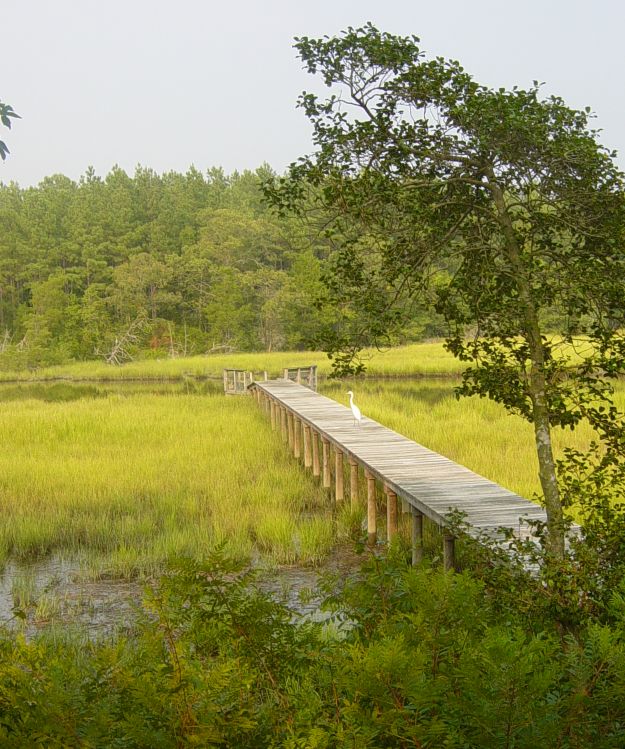MUSINGS
FROM THE MARSH
Ann
Woodlief
I. Coming to the Marsh

Marshes are soggy, smelly, humid places where mosquitoes and other nasty, biting bugs reign. Who would ever want to live there? I would, but keep the myth alive, please. Paradise should not be crowded.
A dozen years ago we bought seven-plus acres on an isolated tidal marsh. About two acres were scrubby abandoned farmland, along more than an acre of marsh with a tidal creek winding around its eastern edge. Across a dirt road that ran through our little neighborhood was the rest-scrub pines and a large swamp, too shallow to boat and too deep to explore.
I bushwhacked my way to the edge of the marsh, brushing aside green briars to look down the southeast length of the winding creek, listening to the birds launch into their sunset songs, and I was hooked.
Though my husband was covered in mosquito bites that August evening, he somehow agreed we could buy this bit of wilderness in lower King and Queen County. For him, it was a potential financial investment; for me, it was a commitment to wilderness.
We were both right and wrong. It has been an investment--we started with a screened gazebo and soon built a house full of windows facing the sunrise. In four years, we had moved to the house full time, commuting an hour to Richmond. Retirement has given us much more time to "know the neighborhood."
And the wilderness? It's not Walden Pond or the Sierras, and our presence has unintentionally and inevitably changed the wildness that was here ten years ago. And yet, at least once a day we have unexpected encounters with wildness, reminders of life which is not human, though affected by our actions in ways that are hard to anticipate or prevent.
Where does one begin?
With
the female blue grosbeak which is now perched on the thistle feeder at my kitchen
window, ignored by the feeding goldfinches? She's not ignoring me, for some reason.
She's been dancing around, pecking at the window, and is now hunched there, staring
at me, two feet away. What's on her mind? Is she looking for a place to nest (it's
May)? Or looking at her reflection, attacking that strange bird there, as the
cardinals did for years? I come within inches, but she doesn't even flinch. I
even put some sunflower seed there, but she's not interested in more than a couple
of seeds. Or what about the gray fox that streaked across the road yesterday
as I was walking back with my mail? He seems to have been hanging around nearby
undeveloped acreage and may have young ones; my neighbor has also spotted a smaller
red fox that was cruising down her pier one evening. And last week, at sunrise,
we saw an otter swimming down the creek. When we moved here, we often saw a pair;
one afternoon I sat in my canoe and watched one playing on the creek bank. But
then they were gone, and my neighbor said he knew of a trapper in the area. Has
one found the creek again? Can it stay free of traps?
There are smaller surprises too-the tiny purple and yellow wildflowers that suddenly cover the lawns, with sulphur and cabbage butterflies hovering and darting. There are the ruby-throated hummingbirds that battle with their own offspring late in the summer, trying to get to the feeders that I now hang out of sight of each other. And there is the bird with the distinction peet-peet-peet-trill song that I've never been able to identify.
Most of
the wildlife stays hidden, but betrays its presence in the spring. The whip-poor-wills
across the marsh can call out all night in the spring and early summer, until
the turkey gobbler starts his early song, in counterpoint with the squawking of
the invisible clapper rails. Every spring is a cliff-hanger: what will return?
Which birds will nest in the boxes this year? When will the tree frogs come back
to eat bugs on the window at night? When will the Mayflies hatch and the chiggers
take over the bushes? Will the lady's slipper bloom again? Will all the birds
and butterflies come back from their southern vacations, or have their habitats
there disappeared? I have learned one profound lesson at the marsh. So often,
you have to imagine a creature before you can encounter it. It's as if you have
created a space-either visual or aural-which fits before it can be filled. How
often I've read or been told about an animal, bird, or plant in the neighborhood,
and suddenly it makes its appearance, when I least expect it.
"Life is a series of surprises, and would not be worth taking or keeping, if it were not, " Emerson said in his essay, "Experience." Certainly, the daily surprises of life at the marsh-or anywhere that one keeps eyes and ears open, and asks questions-are "worth taking."
The female grosbeak is still at the window, following me with her eyes. Mosquitoes make great bird food-and so do mayflies, I hope. The great blue heron is fishing along the creek, and is flipping an eel in its beak, trying to swallow it. The groundhog is standing sentinel at the edge of the marsh between quick bites of grass-or more likely, weeds. And the bird I can't identify is singing its heart out. Overhead I just spotted the bald eagle with a couple of soaring vultures.
It's just another day at the marsh. You wouldn't like living here, I hope.
Pleasant Living Magazine, July/August 2005